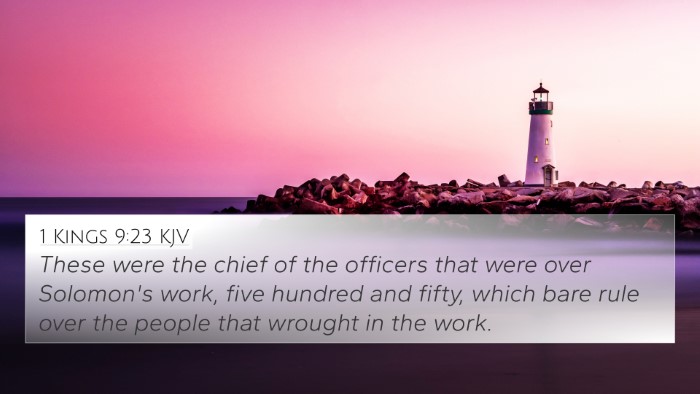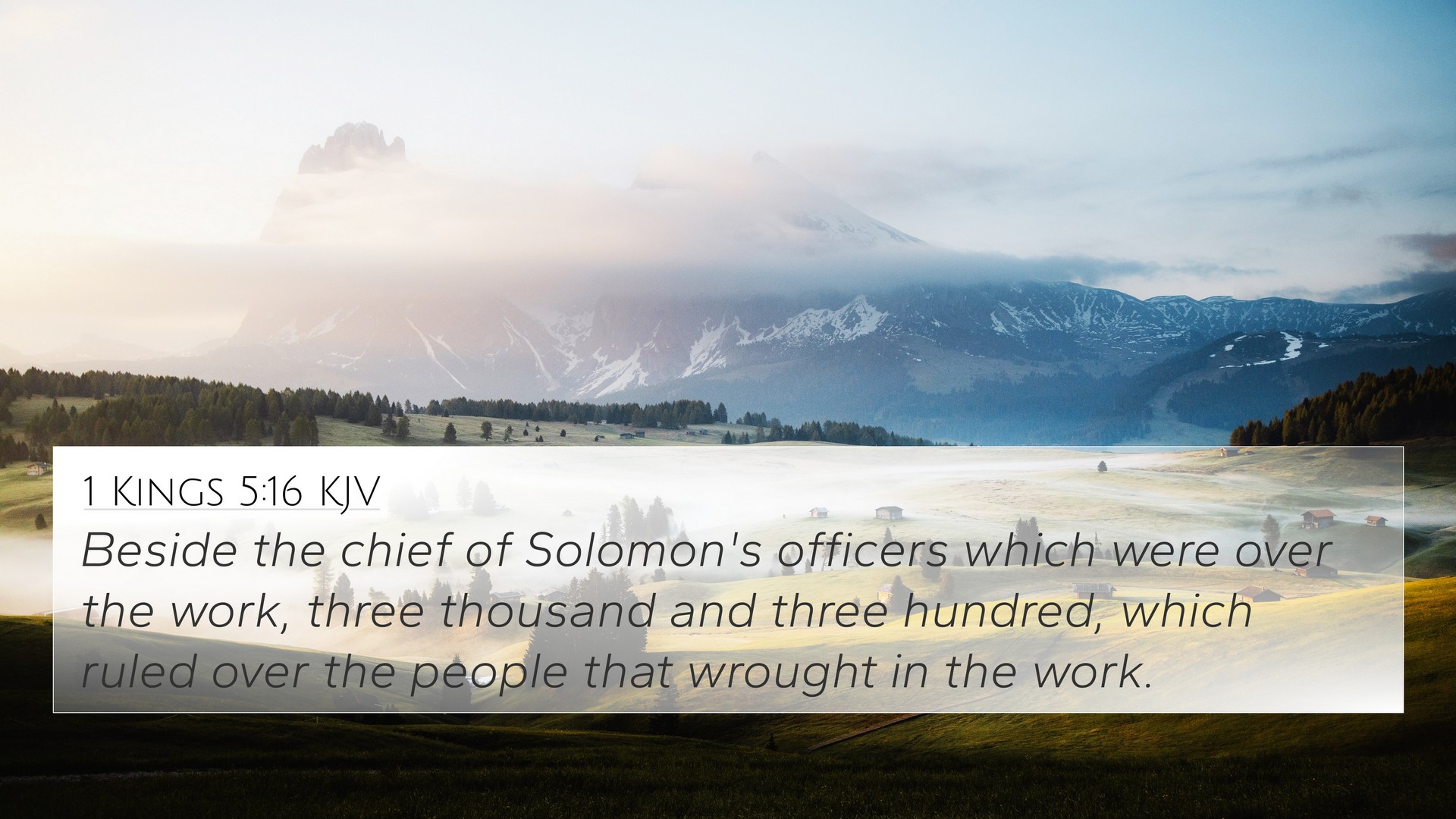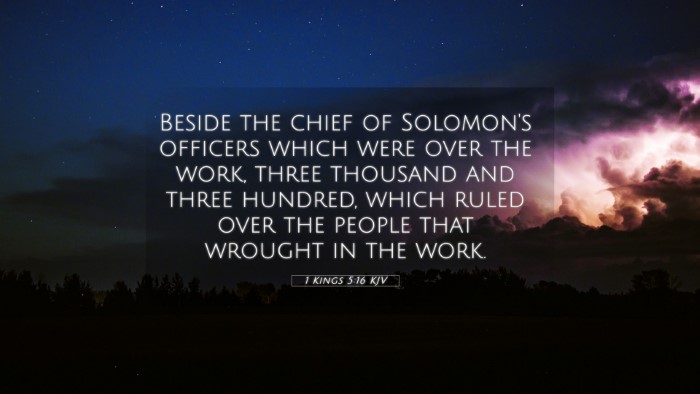Old Testament
Genesis Exodus Leviticus Numbers Deuteronomy Joshua Judges Ruth 1 Samuel 2 Samuel 1 Kings 2 Kings 1 Chronicles 2 Chronicles Ezra Nehemiah Esther Job Psalms Proverbs Ecclesiastes Song of Solomon Isaiah Jeremiah Lamentations Ezekiel Daniel Hosea Joel Amos Obadiah Jonah Micah Nahum Habakkuk Zephaniah Haggai Zechariah Malachi1 Kings 5:16 Similar Verses
1 Kings 5:16 Cross References
Beside the chief of Solomon's officers which were over the work, three thousand and three hundred, which ruled over the people that wrought in the work.
Uncover the Rich Themes and Topics of This Bible Verse
Listed below are the Bible themes associated with 1 Kings 5:16. We invite you to explore each theme to gain deeper insights into the Scriptures.
1 Kings 5:16 Cross Reference Verses
This section features a detailed cross-reference designed to enrich your understanding of the Scriptures. Below, you will find carefully selected verses that echo the themes and teachings related to 1 Kings 5:16 KJV. Click on any image to explore detailed analyses of related Bible verses and uncover deeper theological insights.

1 Kings 9:23 (KJV) »
These were the chief of the officers that were over Solomon's work, five hundred and fifty, which bare rule over the people that wrought in the work.

2 Chronicles 2:2 (KJV) »
And Solomon told out threescore and ten thousand men to bear burdens, and fourscore thousand to hew in the mountain, and three thousand and six hundred to oversee them.
1 Kings 5:16 Verse Analysis and Similar Verses
Understanding 1 Kings 5:16
Verse: 1 Kings 5:16 - "And Solomon had threescore and ten thousand that bare burdens, and fourscore thousand hewers in the mountains;"
Summary and Analysis
This verse highlights the organized labor force that King Solomon assembled for the construction of the Temple in Jerusalem. It reflects not only the scale of the work but also the strategic planning involved in such a monumental endeavor.
Contextual Background
In this section, we explore the broader context of Solomon's reign and the significance of the Temple's construction. Solomon is recognized for his wisdom, wealth, and the establishment of a peaceful kingdom, which facilitated his grand building projects.
Commentary Insights
- Matthew Henry: He emphasizes the enormity of the task at hand and the great resources Solomon commanded. He notes that having such a workforce illustrates the prosperity and strength of Israel under Solomon's rule.
- Albert Barnes: Barnes discusses the logistics involved in managing such a large workforce and points out that Solomon's skilled management reflects his wisdom. He also contrasts Solomon's peace and prosperity with the hardships faced by his subjects who bore the burden of such grand projects.
- Adam Clarke: In his commentary, Clarke mentions the various roles within the labor force, highlighting the organization necessary for such a large project. He notes that these workers played a crucial role in the fulfillment of God's promise to David regarding the temple's construction.
Key Themes
- Labor and Leadership: The necessity of skilled labor under effective leadership speaks volumes about the importance of governance in achieving large-scale objectives.
- Building and Community: The efforts undertaken to construct the Temple signify a community working towards a common spiritual goal.
- Divine Purpose: Solomon’s motivation to build the Temple reflects a desire to honor God, showcasing the intertwining of divine purpose with human effort.
Cross-References
This verse connects with several others throughout the Bible, illustrating themes of labor, divine purpose, and the importance of worship places:
- 1 Chronicles 22:2: "And David commanded to gather together the strangers that were in the land of Israel; and he set masons to hew wrought stones to build the house of God."
- 2 Chronicles 2:2: "And Solomon told out threescore and ten thousand men to bear burdens, and fourscore thousand to hew in the mountains, and three thousand six hundred to oversee them."
- Exodus 35:35: "Them hath he filled with wisdom of heart, to work all manner of work, of the engraver, and of the cunning workman, and of the weaver,..."
- Isaiah 44:28: "...that saith of Cyrus, He is my shepherd, and shall perform all my pleasure: even saying to Jerusalem, Thou shalt be built; and to the temple, Thy foundation shall be laid."
- Matthew 21:12: "And Jesus went into the temple of God, and cast out all them that sold and bought in the temple; and overthrew the tables of the money changers, and the seats of them that sold doves."
- John 2:19: "Jesus answered and said unto them, Destroy this temple, and in three days I will raise it up."
- Acts 7:47-50: "But Solomon built him a house. Howbeit the most High dwelleth not in temples made with hands; as saith the prophet..."
Connections Between Bible Verses
The connections between these verses display a pattern of labor, spiritual significance, and the beauty of God’s dwelling among His people. Solomon's construction efforts not only fulfilled a physical need for a temple but also established a lasting spiritual legacy.
Thematic Bible Verse Connections
By diving deeper into the themes found in 1 Kings 5:16 and its cross-references, we can observe key topics such as:
- The Importance of Unity: The laborers came together from various backgrounds, symbolizing a unified community working for a spiritual goal.
- Wisdom in Leadership: The effectiveness of Solomon's leadership showcases the critical role of wisdom in executing divine mandates.
- God's Faithfulness: The fulfillment of God's promises through the building of the temple highlights His faithfulness to His people.
Comparison of Biblical Texts
In consulting various texts, we can appreciate how the themes evolve across the scriptures, providing enrichment for our understanding of God's plan through labor and community. This leads to a deeper exploration of how these constructions symbolize God's desire to dwell among His people.
Practical Applications
Understanding the significance of labor in spiritual matters allows us to reflect on our contributions to our religious communities. Recognizing the efforts of those who came before us, we should be inspired to build up our faith and community.
Tools for Bible Cross-Referencing
When looking for deeper connections in the Word, utilizing Bible concordances, cross-reference guides, and Bible study methods can aid tremendously. Here are some practical tips:
- Utilize a Bible concordance to find keywords and topics linked to specific verses.
- Follow a cross-reference Bible study approach to explore how different scriptures relate to each other.
- Develop your own Bible reference resources by noting personal insights during your study.


